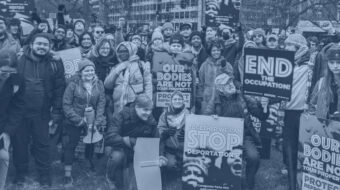America’s recent wars have killed many hundreds of American soldiers on the battlefields. There is something else going on that is far more difficult to see – those who survive the fighting are coming home with terrible medical problems by the tens of thousands. Take a look at these facts:
• Estimated Gulf War I (1991) veterans: 573,000
• Average soldier exposure to ground campaign: 100 hours
• Number of air battle sorties: 32,000
• Number of U.S. casualties: 148 killed, 467 wounded
However, the Departments of Defense and Veterans Affairs are paying out medical disability payments to 221,000 Gulf War veterans. Another 52,000 have claims in for the same status, as of about a year ago. In other words, 39 percent of all the vets who fought in the Gulf War have already been determined by the military to be disabled!
Compare this to the rate of approved medical disability claims during World War II (6.6 percent), Korea (5 percent) and Vietnam (9.6 percent).
Why are our vets coming home so sick? Could it be the 320 tons of depleted uranium (DU) dust that litters the battlefield?
“Part of the threat today includes greater exposure to battlefield by-products of ‘depleted uranium’ munitions used in combat,” notes Dr. Doug Rokke, former director of the Army’s depleted uranium project.
“People are sick over there already,” according to Rokke. “It’s not just uranium. You’ve got all the complex organics and inorganics (compounds) that are released in those fires and detonations. And they’re sucking this in. … You’ve got the whole toxic wasteland.”
In 1991, Desert Storm commander Gen. Norman Schwarzkopf asked Rokke to oversee the environmental cleanup and medical care of soldiers injured in friendly fire incidents involving DU weapons. Rokke later wrote the DU safety rules adopted by the Army, but was relieved of subsequent duties after he criticized commanders for not following those rules and not treating troops exposed during NATO’s war in Yugoslavia.
DU, or Uranium-238, is a by-product of the production of nuclear reactor fuel. It is denser and more penetrating than lead, burns as it flies, and breaks up and vaporizes on impact – which makes it very deadly. Each round fired by a tank shoots one 10-pound uranium dart. In addition to destroying targets, those darts scatter into burning fragments and create a cloud of uranium particles as small as one micron. Particles that small can enter lung tissue and remain embedded there.
The Pentagon’s acknowledged failure to follow a 1997 law requiring baseline medical screening of troops before and after deployment complicates efforts to understand potential health impacts. But Rokke says health problems associated with DU exposure are likely to be even more widespread in the current Iraqi war than in 1991. That’s because the military relies more heavily on DU munitions today, and there’s more fighting in this war.
It has become commonplace for us to see images on television of soldiers and civilians driving past burning Iraqi trucks that have been destroyed by tank fire. We often see soldiers or civilians inspecting buildings destroyed by missiles. These people are not wearing respirators, notes Rokke, and they all risk radiation poisoning, which can have lifelong consequences.
“He’s going to be sick,” Rokke said about one such soldier. “He’s supposed to have full respiratory protection on. That’s required by his (training manual). And when he comes by and he’s downwind, he is supposed to have a radiobioassay. That’s urine, feces and nasal swabs within 24 hours.”
When asked why those protocols – part of the DU rules he wrote for the Army – apparently aren’t being followed, Rokke responds that the military doesn’t want to lose the use of DU weapons. He noted that as early as 1991, the military issued memos saying DU ammo could become “politically unacceptable and thus be deleted” if health and environmental impacts were emphasized.
So the picture is clear. The same political friends of Halliburton and the oil industry who send us off to wage “preemptive” wars around the world are waging war on our own soldiers. It is, indeed, time to struggle for “regime change” – right here in the USA!
The author can be reached at pww@pww.org.










